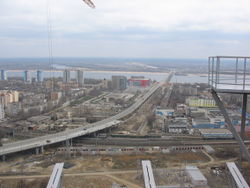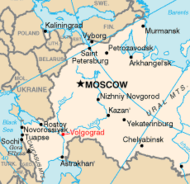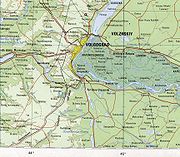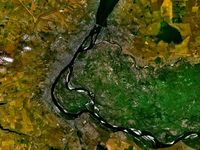Volgograd
| Volgograd (English) Волгоград (Russian) |
|
|---|---|
| — City — | |
 View of Volgograd |
|
 Volgograd on the map of European Russia |
|
| Coordinates: | |
 |
 |
| City Day | Second Sunday of September |
| Administrative status | |
| Country | Russia |
| Federal subject | Volgograd Oblast |
| Administrative center of | Volgograd Oblast |
| Municipal status | |
| Urban okrug | Volgograd Urban Okrug |
| Head | Roman Grebennikov |
| Representative body | City Duma |
| Statistics | |
| Area | 565 km2 (218 sq mi) |
| Population (2002 Census) | 1,011,417 inhabitants[1] |
| - Rank | 12th |
| - Density | 1,790 /km2 (4,600 /sq mi)[2] |
| Time zone | MSK/MSD (UTC+3/+4) |
| Founded | 1555 |
| Previous names | Tsaritsyn (until 1925), Stalingrad (until 1961) |
| Postal code(s) | 400001..400138 |
| Dialing code(s) | +7 8442 |
| Official website | |
Volgograd (Russian: Волгоград; IPA: [ˌvɐlɡəˈɡrat]), formerly called Tsaritsyn (Russian: Цари́цын) (1589–1925) and Stalingrad (Russian: Сталингра́д) (1925–1961) is an important industrial city and the administrative center of Volgograd Oblast, Russia. It is 80 kilometres (50 mi) long, north to south, situated on the western bank of the Volga River and has a population of 1.011 million people. The city was made famous for its resistance and extensive damage during the Battle of Stalingrad during World War II.
Contents |
History
_(1857).png)
Volgograd originated with the foundation in 1589 of Tsaritsyn at the confluence of the Tsaritsa and Volga Rivers. The fortress Sary Su (a local Tatar language name meaning: Yellow Water/River), was established to defend the unstable southern border of Tsarist Russia. It soon became the nucleus of a trading settlement. It was captured twice by Cossack rebels, under Stepan Razin in the rebellion of 1670 and Yemelyan Pugachev in 1774. Tsaritsyn became an important river port and commercial centre in the 19th century.
The city was the scene of heavy fighting during the Russian Civil War. Bolshevik forces occupied it during 1918, but were attacked by White forces under Anton Ivanovich Denikin.
The original name of the city, Tsaritsyn, was first recorded by English explorer Barry in 1579, though he did not refer to the city, but to the island on the Volga. The origin of the name is usually traced back to the Turkic "Sary-Su" (yellow water) or "Sary-Sin" (Yellow Island). The date of the founding of the city is considered to be July 2, 1589, when the fortress Tsaritsyn was first named in a royal charter. The fortress was located slightly above the confluence of the Volga River Queen on the right bank.
Before the Tsarina, in the mouth of the river, there was a settlement of the Queen of the Golden Horde.
In 1607, the fortress was in revolt against the king's troops but was suppressed six months later. In 1608, the city had its first stone church, St. John the Baptist.
At the beginning of the seventeenth century, the garrison consisted of 350-400 people.
In 1670 the fortress was taken by troops of Stepan Razin, who left after a month. In 1708, the fortress was held by insurgent Cossacks Kondrati Bulavin. In 1717, Bulavin was sacked by the Crimean Tatars and Kuban. Later, in 1774, the city unsuccessfully stormed Yemelyan Pugachev.
In 1691, Tsaritsyn established customs. In 1708, Tsaritsyn was assigned to the Kazan province; in 1719, to Astrakhan; from 1779, to the Saratov Viceroyalty. In 1773, the city became the provincial and district town. In 1780, the city was under the Saratov governorship (later as a province). According to the census in 1720, the city's population was 408 people.
The population expanded rapidly during the 19th century, increasing from fewer than 3000 people in 1807 to about 84,000 in 1900.
The first railroad came to the town in 1862. The first theater opened in 1872, the first cinema in 1907. In 1913, Tsaritsin's first tram line was built, and the city's first electric lights were installed in the city center.
During the Russian civil war Tsaritsyn was under Soviet control starting from November 1917. In 1918, Tsaritsyn was besieged by White troops under Ataman Krasnov. Three assault were repulsed. However, in June 1919 Tsaritsyn was captured by White forces of General Denikin, which left the city in January 1920.
The city was renamed Stalingrad after Joseph Stalin on April 10, 1925. This was officially to recognise the city's role in its defence against the White Russians in 1918-1920[3].
In 1931, in the city including the German settlement-colony Sarepta (founded in 1765), subsequently became the largest area of the city - Krasnoarmeysky. The first institute was opened in 1930, a year later was opened and the Pedagogical Institute.
Under Stalin, the city became a center of heavy industry and transshipment by rail and river, and as a result was attacked by Axis forces during World War II. In 1942, the city became the site of one of the pivotal battles of the war. The Battle of Stalingrad saw perhaps the greatest casualty figures of any battle in warfare (estimates are between 1,250,000[4] and 1,798,619[5]). The battle began on 17 July 1942, and on August 23 the city suffered heavy aerial bombardment that reduced most of it to rubble. By September, the fighting reached the city center. The fighting was of unprecedented intensity; the central station of the city passed from hand to hand 13 times, and the famous Mamayev Kurgan (one of the heights of the city) was captured and recaptured 8 times. By the winter of 1942–43, the German forces controlled 90% of the city, and had cornered the Soviets into two narrow pockets. On November 19, Soviet forces launched a massive counterattack. This led to the eventual encirclement of the Sixth German Army. On January 31, 1943 its commander, Field Marshal Friedrich von Paulus surrendered, and on February 2, with the elimination of straggling German troops, the Battle of Stalingrad was over.
Stalingrad was awarded the title Hero City for its heroism in 1945, and King George VI of the United Kingdom awarded the citizens of Stalingrad the jeweled "Sword of Stalingrad" in admiration of their bravery. A memorial complex commemorating the battle, dominated by an immense allegorical sculpture of Mother Russia, was erected on the Mamayev Kurgan, the hill that saw some of the most intense fighting during the battle. A number of cities around the world (especially that which had suffered similar wartime devastation) established sister/friendship/twinning links (see list below) in the spirit of solidarity or reconciliation. One of the first "sister city" projects was that established between Stalingrad and Britain's Coventry during World War II (as both suffered extensive devastation from aerial bombardment).
The Panorama Museum sited on the Volga contains artifacts from World War II. These include a panoramic painting of the battlefield from the location of the monument on Mamayev Kurgan. A rifle of the famous sniper Vasily Zaytsev (popularized in Western media in the film Enemy at the Gates) is also on display. Vasily Zaytsev is also widely presented as a hero in the movie "Stalingrad".
In 1961, the name was changed from Stalingrad to Volgograd ("Volga City") as part of Nikita Khrushchev's programme of de-Stalinization. This was and remains somewhat contentious, given the fame of the name "Stalingrad" and its importance in wartime remembrance. There were serious proposals to revert the name to "Stalingrad" during Konstantin Chernenko's brief administration in 1985. There remains a strong degree of local support for a reversion but intermittent proposals have been not yet accepted by the Russian government.
On May 21, 2007, the CPRF or Communist Party of the Russian Federation obtained an important success in the Volgograd mayoral election. Communist candidate Roman Grebennikov was elected as mayor with 32.47% of the vote. Grebennikov is Russia's youngest mayor of a regional capital.
Economy
Modern Volgograd remains an important industrial city. Industries include shipbuilding, oil refining, steel and aluminium production, manufacture of machinery and vehicles, and chemical production. A large Volgograd Hydroelectric Plant stands a short distance to the north of Volgograd.

Transport
Volgograd is a major railway junction serviced by Pri Volga Railway. Rail links include Moscow; Saratov; Astrakhan; the Donbas region of Ukraine; the Caucasus and Siberia. It stands at the east end of the Volga-Don Canal, opened in 1952 to link the two great rivers of Southern Russia. European route E40, the longest European route connecting Calais, France with Ridder, Kazakhstan, passes through Volgograd. The M6 highway between Moscow and the Caspian Sea also passes through the city. The Volgograd Bridge, under construction since 1995, was inaugurated in October 2009.[6] The city river terminal is the centre for local passenger shipping along the Volga river.
Volgograd International Airport provides air links to major Russian cities as well as Antalya, Yerevan and Aktau.
Volgograd's public transport system includes a light rail service known as the Volgograd metrotram. Local public transport is provided by buses, trolleybuses and trams.
Climate
Volgograd has a semi-arid or steppe climate (Köppen climate classification BSk)
| Climate data for Volgograd | |||||||||||||
|---|---|---|---|---|---|---|---|---|---|---|---|---|---|
| Month | Jan | Feb | Mar | Apr | May | Jun | Jul | Aug | Sep | Oct | Nov | Dec | Year |
| Record high °C (°F) | 12.0 (53.6) |
14.0 (57.2) |
21.4 (70.5) |
28.9 (84) |
37.7 (99.9) |
39.2 (102.6) |
39.8 (103.6) |
40.0 (104) |
38.0 (100.4) |
31.5 (88.7) |
18.2 (64.8) |
11.0 (51.8) |
40.0 (104) |
| Average high °C (°F) | -4.5 (23.9) |
-4.3 (24.3) |
2.6 (36.7) |
15.4 (59.7) |
22.7 (72.9) |
26.9 (80.4) |
29.3 (84.7) |
27.9 (82.2) |
21.6 (70.9) |
12.2 (54) |
4.0 (39.2) |
-1.9 (28.6) |
12.7 (54.9) |
| Average low °C (°F) | -10.7 (12.7) |
-10.7 (12.7) |
-4.5 (23.9) |
5.1 (41.2) |
12.0 (53.6) |
16.1 (61) |
18.4 (65.1) |
17.1 (62.8) |
11.6 (52.9) |
4.0 (39.2) |
-1.3 (29.7) |
-7.0 (19.4) |
4.2 (39.6) |
| Record low °C (°F) | -32.6 (-26.7) |
-32.1 (-25.8) |
-26.1 (-15) |
-10.1 (13.8) |
-2.6 (27.3) |
2.0 (35.6) |
7.0 (44.6) |
2.8 (37) |
-3.0 (26.6) |
-12.2 (10) |
-21.7 (-7.1) |
-29.5 (-21.1) |
-32.6 (-26.7) |
| Precipitation mm (inches) | 10.0 (0.394) |
11.3 (0.445) |
26.2 (1.031) |
37.5 (1.476) |
58.6 (2.307) |
53.9 (2.122) |
55.7 (2.193) |
51.2 (2.016) |
48.0 (1.89) |
32.4 (1.276) |
15.8 (0.622) |
9.9 (0.39) |
410.5 (16.161) |
| Source: Гидрометцентр России[7][8] | |||||||||||||
Education
Institutions include:
- Volgograd State University,
- Volgograd State Technical University (former Volgograd Polytechnical University),
- Volgograd State Medical University,
- Volgograd State University of Architecture and Civil Engineering,
- Volgograd Academy of Industry, * Volgograd Academy of Business Administration, and
- Volgograd State Pedagogical University.
Sport
FC Volgograd and FC Rotor Volgograd are both Russian Second Division football clubs, having been relegated after being in the Russian Premier League in the early 1990s. Lukoil-Spartak represent the city in water polo.
Famous residents
- Kurt Adler - Operatic Conductor (1935–1937)
- Ilya Borodin - footballer
- Zakhar Dubenskiy - footballer
- Sasha Fillipov - Red Army spy
- Oleg Grebnev - hand ball player
- Larisa Ilchenko - long distance swimmer
- Yelena Isinbayeva, pole vaulter
- Lev Ivanov (football manager)
- Yuriy Kalitvintsev, Ukrainian football manager
- Elem Klimov, film director
- Vladimir Kryuchkov, politician
- Tatyana Lebedeva, long jumper and triple jumper
- Maxim Marinin, figure skater
- Maxim Opalev, sprint canoer
- Denis Pankratov Olympic swimmer
- Aleksandra Pakhmutova, composer
- Anton Sakharov, footballer
- Oleg Sergeyev, footballer
- Natalia Shipilova, handball player
- Yelena Slesarenko, high jumper
- Igor Vasilev, handball player
- Oleg Veretennikov, footballer
- Evgeni Plushenko, Olympic gold medal figure skater
- Nikolay Davydenko, tennis player
- Anna Chapman, (born Anya Kushchenko) Russian agent who operated in the United States
International relations
Twin towns — Sister cities
Volgograd is twinned with:[9][10]
|
- A number of communities in France and Italy have streets or avenues named after Stalingrad, hence Place de Stalingrad in Paris and the eponymous Paris Métro station of Stalingrad.
Gallery
 Volgograd from Space |
 Map of Volgograd's City Districts |
 Underground station of Volgograd metrotram — Lenin's Square |
 Volgograd State Medical University (left) and New Experimental Theater of Volgograd |
|
Volgograd railway station |
References
- ↑ Федеральная служба государственной статистики (Federal State Statistics Service) (2004-05-21). "Численность населения России, субъектов Российской Федерации в составе федеральных округов, районов, городских поселений, сельских населённых пунктов – районных центров и сельских населённых пунктов с населением 3 тысячи и более человек (Population of Russia, its federal districts, federal subjects, districts, urban localities, rural localities—administrative centers, and rural localities with population of over 3,000)" (in Russian). Всероссийская перепись населения 2002 года (All-Russia Population Census of 2002). Federal State Statistics Service. http://perepis2002.ru/ct/html/TOM_01_04_1.htm. Retrieved 2009-08-19.
- ↑ The value of density was calculated automatically by dividing the 2002 Census population by the area specified in the infobox. Please note that this value may not be accurate as the area specified in the infobox does not necessarily correspond to the area of the entity proper or is reported for the same year as the Census (2002).
- ↑ Breweres Dictionary of 20th Century Phrase and Fable
- ↑ Grant, R. G. (2005). Battle: A Visual Journey Through 5,000 Years of Combat. Dorling Kindersley. ISBN 0756613604. http://books.google.com/books?id=iU-pAQAACAAJ&ei=OtqJSa-lLJTUlQTVuu3rAQ.
- ↑ Wagner, Margaret, et al. (2007). The Library of Congress World War II Companion. Simon & Schuster. ISBN 0743252195. http://books.google.com/books?id=0bRaa7UuD6EC.
- ↑ "Ivanov otkryl v Volgograde samyi bolshoy most v Evrope (Иванов открыл в Волгограде самый большой мост в Европе)" (in Russian). Vesti. http://www.vesti.ru/doc.html?id=319840. Retrieved 2009-10-10.
- ↑ "Гидрометцентр России" (in Russian). http://meteoinfo.ru/VolgogradClimat. Retrieved December 14, 2008.
- ↑ http://www.pogoda.ru.net/monitor.php?id=34560&month=7&year=2009
- ↑ Friendly relationship at Official website of Volgograd
- ↑ "VISIT VOLGOGRAD - RUSSIA - WELCOME TO THE CITY - THE HERO VOLGOGRAD!". www.visitvolgograd.info. http://www.visitvolgograd.info/Vennskapsbyer.htm. Retrieved 2010-01-05.
- ↑ "広島市の姉妹・友好都市". City.hiroshima.jp. http://www.city.hiroshima.jp/shimin/kokusai/shimai/top-e.html. Retrieved 2009-07-17.
- ↑ "Ruse Municipality - Fraternize Cities". © 2008-2009 Ruse Municipality. http://www.ruse-bg.eu/index.php?area=2&p=gallery&action=showimages&galid=18. Retrieved 2009-07-06.
- ↑ Executive power of Baku city
External links
- Official website of Volgograd (English)
- (Russian) Official website of Volgograd
- (Russian) Volgograd.ru — City Web Portal, Local Business and Web Directory, News, Press, Webcams, 3D Mamayev Kurgan
- Over 2,000 original German WWII soldier photographs from the Eastern Front
- VISITVOLGOGRAD.INFO Tourist Information
- Sights of Volgograd
- Photo Gallery from Volgograd
- Stalingrad - Bilder einer erbitterten Schlacht (German)
- Volgograd city streets views
- Volgograd State University
|
||||||||||||||
|
|||||